Overview
- Brief Narrative
- Chalk used by Alexander Stankiewicz while an inmate at Mauthausen concentration camp where he worked as a barber. Stankiewicz was a Roman Catholic Pole, living in Wloclawek, (Leslau) Poland, who was arrested in 1941 by the occupying Germans for his membership in a Polish political and literary organization. At Mauthausen, his prisoner number was 24993. After the war ended in 1945, he returned to Poland.
- Date
-
use:
approximately 1941-1945
- Geography
-
issue:
Mauthausen (Concentration camp);
Mauthausen (Austria)
- Credit Line
- United States Holocaust Memorial Museum Collection, Gift of Jan Niebrzydowski
- Contributor
-
Subject:
Alexander Stankiewicz
- Biography
-
Alexander Stankiewicz, a Roman Catholic, was born on November 16, 1903, in Kamienskoje (or Kaminsk) Poland (or Russia). He was of Polish nationality and lived with his mother, Stanislawa Raczowska. He was barber and hairdresser. In 1941, he lived in Wloclawek, Poland, called Leslau by the occupying Germans. He was arrested February 16 for membership in a Polish political and literary organization, Kujawski Zwiazek Polityczno Literacki Zew. He was sentenced to prison and sent to Mauthausen concentration camp in Austria. His prisoner number was 24993. On March 11, 1943, he was transferred to a work detail in a nearby subcamp in Linz. After the war, he returned to Poland.
Physical Details
- Classification
-
Office Equipment and Supplies
- Category
-
Writing materials
- Object Type
-
Chalk sticks (lcsh)
- Physical Description
- White, worn, rectangular cube of chalk with scratches and a brown stain on one corner.
- Dimensions
- overall: Height: 1.000 inches (2.54 cm) | Width: 0.500 inches (1.27 cm) | Depth: 0.500 inches (1.27 cm)
- Materials
- overall : chalk
Rights & Restrictions
- Conditions on Access
- No restrictions on access
- Conditions on Use
- No restrictions on use
Keywords & Subjects
Administrative Notes
- Legal Status
- Permanent Collection
- Provenance
- The chalk was donated to the United States Holocaust Memorial Museum in 2005 by Jan Niebrzydowski.
- Record last modified:
- 2022-07-28 18:28:57
- This page:
- https://collections.ushmm.org/search/catalog/irn517734
Download & Licensing
In-Person Research
- By Appointment
- Request 21 Days in Advance of Visit
- Plan a Research Visit
- Request to See This Object
Contact Us
Also in Alexander Stankiewicz collection
The collection consists of artifacts and documents relating to the experience of Alexander Stankiewicz in Mauthasuen concentration camp in Austria during the Holocaust.
Date: 1941-1945
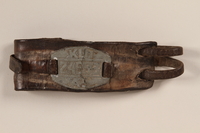
Leather wristband with numbered identification tag issued in a concentration camp
Object
Wristband worn by Alexnder Stankiewicz with his prisoner identification number, 24993, for Mauthausen concentration camp. Stankiewicz was a Roman Catholic Pole, living in Wloclawek (Lesalu), Poland, who in 1941 was arrested and sent to Mauthausen by the occupying German for his membership in a Polish political and literary organization. He worked as a barber in the camp. After the war ended in 1945, he returned to Poland.
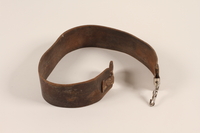
Leather razor strop used by a barber in a concentration camp
Object
Barber's strop used by Alexander Stankiewicz while an inmate at Mauthausen concentration camp where he worked as a barber. Stankiewicz was a Roman Catholic Pole, living in Wloclawek, (Leslau) Poland, who in 1941 was arrested and imprisoned by the occupying Germans for his membership in a Polish political and literary organization. At Mauthausen, his prisoner number was 24993. After the war ended in 1945, he returned to Poland.
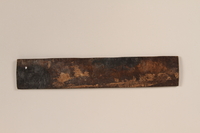
Partial leather razor strop used by a barber in a concentration camp
Object
Fragment of a barber's razor strop by Alexander Stankiewicz while an inmate at Mauthausen concentration camp where he worked as a barber. Stankiewicz was a Roman Catholic Pole, living in Wloclawek, (Leslau) Poland, who in 1941 was arrested and imprisoned by the occupying Germans for his membership in a Polish political and literary organization. At Mauthausen, his prisoner number was 24993. After the war ended in 1945, he returned to Poland.
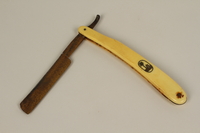
Straight razor used in a concentration camp
Object
Razor used by Alexander Stankiewicz while an inmate at Mauthausen concentration camp where he worked as a barber. Stankiewicz was a Roman Catholic Pole, living in Wloclawek, (Leslau) Poland, who was arrested in 1941 by the occupying Germans for his membership in a Polish political and literary organization. At Mauthausen, his prisoner number was 24993. After the war ended in 1945, he returned to Poland.
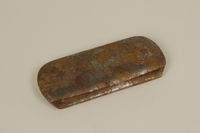
Metal eyeglass case used in concentration camp
Object
Eyeglass case used by Alexander Stankiewicz while an inmate at Mauthausen concentration camp where he worked as a barber. Stankiewicz was a Roman Catholic Pole, living in Wloclawek, (Leslau) Poland, who was arrested in 1941 by the occupying Germans for his membership in a Polish political and literary organization. At Mauthausen, his prisoner number was 24993. After the war ended in 1945, he returned to Poland.
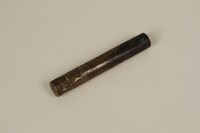
Metal tube for a menthol inhaler used in concentration camp
Object
Case for a menthol inhaler used by Alexander Stankiewicz while an inmate at Mauthausen concentration camp where he worked as a barber. Stankiewicz was a Roman Catholic Pole, living in Wloclawek, (Leslau) Poland, who was arrested in 1941 by the occupying Germans for his membership in a Polish political and literary organization. At Mauthausen, his prisoner number was 24993. After the war ended in 1945, he returned to Poland.
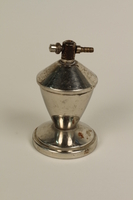
Metal atomizer used in a concentration camp
Object
Atomizer used by Alexander Stankiewicz while an inmate at Mauthausen concentration camp where he worked as a barber. Stankiewicz was a Roman Catholic Pole, living in Wloclawek, (Leslau) Poland, who was arrested in 1941 by the occupying Germans for his membership in a Polish political and literary organization. At Mauthausen, his prisoner number was 24993. After the war ended in 1945, he returned to Poland.
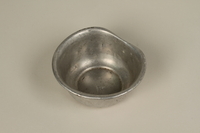
Small metal bowl used in a concentration camp
Object
Tin bowl used by Alexander Stankiewicz while an inmate at Mauthausen concentration camp where he worked as a barber. Stankiewicz was a Roman Catholic Pole, living in Wloclawek, (Leslau) Poland, who was arrested in 1941 by the occupying Germans for his membership in a Polish political and literary organization. At Mauthausen, his prisoner number was 24993. After the war ended in 1945, he returned to Poland.
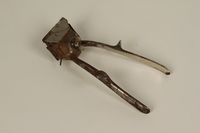
Manual hair clipper with blade guard used in a concentration camp
Object
Clipper used by Alexander Stankiewicz while an inmate at Mauthausen concentration camp where he worked as a barber. Stankiewicz was a Roman Catholic Pole, living in Wloclawek, (Leslau) Poland, who was arrested in 1941 by the occupying Germans for his membership in a Polish political and literary organization. At Mauthausen, his prisoner number was 24993. After the war ended in 1945, he returned to Poland.
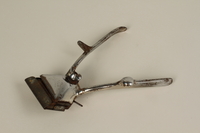
Manual hair clipper with blade guard used in a concentration camp
Object
Hair clipper used by Alexander Stankiewicz while an inmate at Mauthausen concentration camp where he worked as a barber. Stankiewicz was a Roman Catholic Pole, living in Wloclawek, (Leslau) Poland, who was arrested in 1941 by the occupying Germans for his membership in a Polish political and literary organization. At Mauthausen, his prisoner number was 24993. After the war ended in 1945, he returned to Poland.
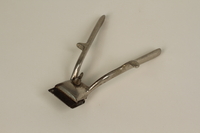
Manual hair clipper used in a concentration camp
Object
Hair clipper used by Alexander Stankiewicz while an inmate at Mauthausen concentration camp where he worked as a barber. Stankiewicz was a Roman Catholic Pole, living in Wloclawek, (Leslau) Poland, who was arrested in 1941 by the occupying Germans for his membership in a Polish political and literary organization. At Mauthausen, his prisoner number was 24993. After the war ended in 1945, he returned to Poland.
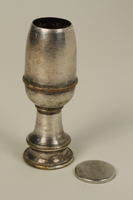
Traveling shaving brush container from a concentration camp
Object
Shaving brush handle used by Alexander Stankiewicz while an inmate at Mauthausen concentration camp where he worked as a barber. Stankiewicz was a Roman Catholic Pole, living in Wloclawek, (Leslau) Poland, who was arrested in 1941 by the occupying Germans for his membership in a Polish political and literary organization. At Mauthausen, his prisoner number was 24993. After the war ended in 1945, he returned to Poland.
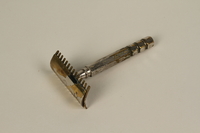
Safety razor used in a concentration camp
Object
Razor used by Alexander Stankiewicz while an inmate at Mauthausen concentration camp where he worked as a barber. Stankiewicz was a Roman Catholic Pole, living in Wloclawek, (Leslau) Poland, who was arrested in 1941 by the occupying Germans for his membership in a Polish political and literary organization. At Mauthausen, his prisoner number was 24993. After the war ended in 1945, he returned to Poland.
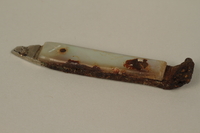
Mother-of-pearl lever arm of a nail clipper used in a concentration camp
Object
Part of a nail clipper used by Alexander Stankiewicz while an inmate at Mauthausen concentration camp where he worked as a barber. Stankiewicz was a Roman Catholic Pole, living in Wloclawek, (Leslau) Poland, who was arrested in 1941 by the occupying Germans for his membership in a Polish political and literary organization. At Mauthausen, his prisoner number was 24993. After the war ended in 1945, he returned to Poland.
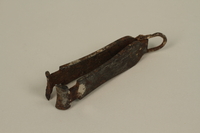
Nail clipper used in a concentration camp
Object
Part of a nail clipper used by Alexander Stankiewicz while an inmate at Mauthausen concentration camp where he worked as a barber. Stankiewicz was a Roman Catholic Pole, living in Wloclawek, (Leslau) Poland, who was arrested in 1941 by the occupying Germans for his membership in a Polish political and literary organization. At Mauthausen, his prisoner number was 24993. After the war ended in 1945, he returned to Poland.
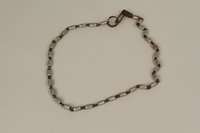
Chain of metal beads used by a barber in a concentration camp
Object
Bead chain used by Alexander Stankiewicz while an inmate at Mauthausen concentration camp where he worked as a barber. The chain resembles those used by German soldiers to clean their rifles. Stankiewicz was a Roman Catholic Pole, living in Wloclawek, (Leslau) Poland, who was arrested in 1941 by the occupying Germans for his membership in a Polish political and literary organization. At Mauthausen, his prisoner number was 24993. After the war ended in 1945, he returned to Poland.
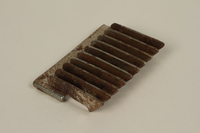
Guide attachment for a manual hair clipper used at a concentration camp
Object
Interchangeable comb attachment used by Alexander Stankiewicz while an inmate at Mauthausen concentration camp where he worked as a barber. Stankiewicz was a Roman Catholic Pole, living in Wloclawek, (Leslau) Poland, who was arrested in 1941 by the occupying Germans for his membership in a Polish political and literary organization. At Mauthausen, his prisoner number was 24993. After the war ended in 1945, he returned to Poland.
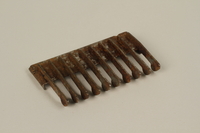
Guide attachment for a manual hair clipper used at a concentration camp
Object
Interchangeable comb attachment used by Alexander Stankiewicz while an inmate at Mauthausen concentration camp where he worked as a barber. Stankiewicz was a Roman Catholic Pole, living in Wloclawek, (Leslau) Poland, who was arrested in 1941 by the occupying Germans for his membership in a Polish political and literary organization. At Mauthausen, his prisoner number was 24993. After the war ended in 1945, he returned to Poland.
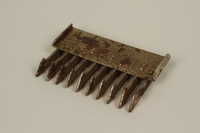
Guide attachment for a manual hair clipper used at a concentration camp
Object
Interchangeable comb attachment used by Alexander Stankiewicz while an inmate at Mauthausen concentration camp where he worked as a barber. Stankiewicz was a Roman Catholic Pole, living in Wloclawek, (Leslau) Poland, who was arrested in 1941 by the occupying Germans for his membership in a Polish political and literary organization. At Mauthausen, his prisoner number was 24993. After the war ended in 1945, he returned to Poland.
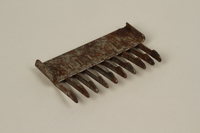
Guide attachment for a manual hair clipper used in a concentration camp
Object
Interchangeable comb attachment used by Alexander Stankiewicz while an inmate at Mauthausen concentration camp where he worked as a barber. Stankiewicz was a Roman Catholic Pole, living in Wloclawek, (Leslau) Poland, who was arrested in 1941 by the occupying Germans for his membership in a Polish political and literary organization. At Mauthausen, his prisoner number was 24993. After the war ended in 1945, he returned to Poland.
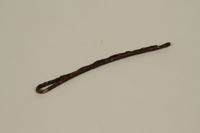
Curved bobby pin used in a concentration camp
Object
Hairpin used by Alexander Stankiewicz while an inmate at Mauthausen concentration camp where he worked as a barber. Stankiewicz was a Roman Catholic Pole, living in Wloclawek, (Leslau) Poland, who was arrested in 1941 by the occupying Germans for his membership in a Polish political and literary organization. At Mauthausen, his prisoner number was 24993. After the war ended in 1945, he returned to Poland.
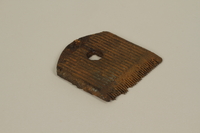
Blade for a manual hair clipper used in a concentration camp
Object
Replacement blade used by Alexander Stankiewicz while an inmate at Mauthausen concentration camp where he worked as a barber. Stankiewicz was a Roman Catholic Pole, living in Wloclawek, (Leslau) Poland, who was arrested in 1941 by the occupying Germans for his membership in a Polish political and literary organization. At Mauthausen, his prisoner number was 24993. After the war ended in 1945, he returned to Poland.
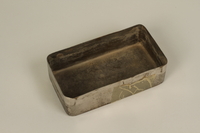
Plated brass syringe sterilizer used in a concentration camp
Object
Plated brass syringe and needle sterilization container used by Alexander Stankiewicz while an inmate at Mauthausen concentration camp where he worked as a barber. Stankiewicz was a Roman Catholic Pole, living in Wloclawek, (Leslau) Poland, who was arrested in 1941 by the occupying Germans for his membership in a Polish political and literary organization. At Mauthausen, his prisoner number was 24993. After the war ended in 1945, he returned to Poland.
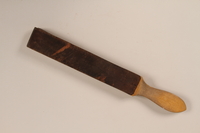
Wood mounted razor strop used by a barber in a concentration camp
Object
Wood-handled strop used by Alexander Stankiewicz while an inmate at Mauthausen concentration camp where he worked as a barber. Stankiewicz was a Roman Catholic Pole, living in Wloclawek, (Leslau) Poland, who was arrested in 1941 by the occupying Germans for his membership in a Polish political and literary organization. At Mauthausen, his prisoner number was 24993. After the war ended in 1945, he returned to Poland.
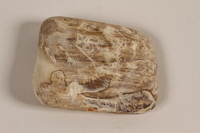
Small used bar of soap from a concentration camp
Object
Soap used by Alexander Stankiewicz while an inmate at Mauthausen concentration camp where he worked as a barber. Stankiewicz was a Roman Catholic Pole, living in Wloclawek, (Leslau) Poland, who was arrested in 1941 by the occupying Germans for his membership in a Polish political and literary organization. At Mauthausen, his prisoner number was 24993. After the war ended in 1945, he returned to Poland.
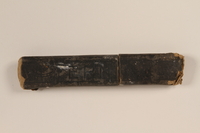
Cardboard case for a straight razor used in a concentration camp
Object
Razor case used by Alexander Stankiewicz while an inmate at Mauthausen concentration camp where he worked as a barber. Stankiewicz was a Roman Catholic Pole, living in Wloclawek, (Leslau) Poland, who was arrested in 1941 by the occupying Germans for his membership in a Polish political and literary organization. At Mauthausen, his prisoner number was 24993. After the war ended in 1945, he returned to Poland.
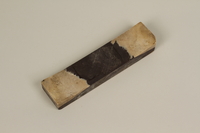
Two-layer whetstone used by a barber in a concentration camp
Object
Blade-sharpening stone used by Alexander Stankiewicz while an inmate at Mauthausen concentration camp where he worked as a barber. Stankiewicz was a Roman Catholic Pole, living in Wloclawek, (Leslau) Poland, who was arrested in 1941 by the occupying Germans for his membership in a Polish political and literary organization. At Mauthausen, his prisoner number was 24993. After the war ended in 1945, he returned to Poland.
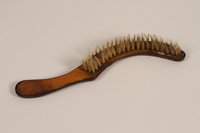
Hat brush used by a barber in a concentration camp
Object
Hat brush used by Alexander Stankiewicz while an inmate at Mauthausen concentration camp where he worked as a barber. Stankiewicz was a Roman Catholic Pole, living in Wloclawek, (Leslau) Poland, who was arrested in 1941 by the occupying Germans for his membership in a Polish political and literary organization. At Mauthausen, his prisoner number was 24993. After the war ended in 1945, he returned to Poland.
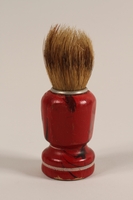
Shaving brush with a white stripe used in a concentration camp
Object
Shaving brush used by Alexander Stankiewicz while an inmate at Mauthausen concentration camp where he worked as a barber. Stankiewicz was a Roman Catholic Pole, living in Wloclawek, (Leslau) Poland, who was arrested in 1941 by the occupying Germans for his membership in a Polish political and literary organization. At Mauthausen, his prisoner number was 24993. After the war ended in 1945, he returned to Poland.
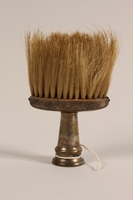
Barber's brush used in a concentration camp
Object
Barber's neck duster used by Alexander Stankiewicz while an inmate at Mauthausen concentration camp where he worked as a barber. Stankiewicz was a Roman Catholic Pole, living in Wloclawek, (Leslau) Poland, who was arrested in 1941 by the occupying Germans for his membership in a Polish political and literary organization. At Mauthausen, his prisoner number was 24993. After the war ended in 1945, he returned to Poland.
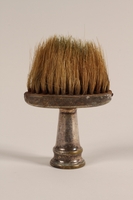
Barber's professional brush used in a concentration camp
Object
Barber's neck duster used by Alexander Stankiewicz while an inmate at Mauthausen concentration camp where he worked as a barber. Stankiewicz was a Roman Catholic Pole, living in Wloclawek, (Leslau) Poland, who was arrested in 1941 by the occupying Germans for his membership in a Polish political and literary organization. At Mauthausen, his prisoner number was 24993. After the war ended in 1945, he returned to Poland.
Alexander Stankiewicz papers
Document
The papers consist of two identification cards for ex-inmates of Mauthausen concentration camp, one pre-printed correspondence form from Mauthausen, and a form from the police chief in Linz, Austria, that relates to the experiences of Stankiewicz, a Polish prisoner in Mauthausen concentration camp. Stankiewicz survived the Holocaust and returned to Poland after liberation.
Wooden box that held barber's kit used in a concentration camp
Object
Wooden box used by Alexander Stankiewicz to hold his barber's tools while he was an inmate at Mauthausen concentration camp. He was a Roman Catholic Pole, living in Wloclawek, (Leslau) Poland, who in 1941 was arrested and sent to Mauthausen by the occupying Germans for his membership in a Polish political and literary organization. At Mauthausen, his prisoner number was 24993. After the war ended in 1945, he returned to Poland.
Shaving brush used in a concentration camp
Object
Shaving brush used by Alexander Stankiewicz while an inmate at Mauthausen concentration camp where he worked as a barber. Stankiewicz was a Roman Catholic Pole, living in Wloclawek, (Leslau) Poland, who was arrested in 1941 by the occupying Germans for his membership in a Polish political and literary organization. At Mauthausen, his prisoner number was 24993. After the war ended in 1945, he returned to Poland.



